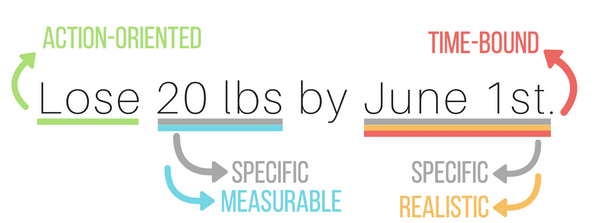Get SMART About Your Fitness Goals

You won’t get anywhere without setting calculated, meaningful goals. We can all say we want to go to the moon, but without the right preparation, planning, or training we won’t ever get there. Making goals with working out or weight loss work the same way. That’s why you should create SMART goals. This stands for specific, measurable, action-oriented, realistic, and time-bound. These restrictions allow you to give yourself goals that you’re better equipped to achieve.
Specific
If your goals are too broad, you won’t be able to determine how well you’re doing. If your goal is just to “work out” and you go to the gym once every two months, then congratulations, you’ve completed your goal and “worked out”, but you haven’t really achieved any meaningful goals. And we’re guessing that wasn’t what you meant when you made your goal. Make your goal specific to push yourself further and really get the best results. Instead of “work out”, try “run on the treadmill for 30 minutes”.
Measurable
Giving yourself an end goal that can actually be measured yields far better results than those that are broad. Your goal may be to lose weight. Well, weight is certainly something that can be measured, so give yourself a number that you can continuously check yourself against and gauge your progress in relation to it. If your goal was to “lose weight” and you lost 5 pounds, that would technically fall into the completion of your goal. But by giving yourself a measurable goal, like 30 pounds, you can see how much that 5 pounds really contributes to your true intention and how far you still have to go.
Action-Oriented
Goals that are action-oriented may involve a specific event or an action to take place in order for you to feel like you’ve completed this goal. Having a concrete action-oriented goal is also a great way to make sure your journey or progress along the way is making you prepared for this goal. For example, your action-oriented goal may be that you want to run a 5k. Every step that you take towards that goal, whether it be increasing the duration of your running time, running on different terrain, etc. will have the endgame of a 5k in mind. You then know which actions you need to take to complete this goal, which leaves you better prepared to complete it successfully.
Realistic
Oftentimes, when we create goals for ourselves we really shoot for the stars. Which isn’t always a bad thing! But, if your goal is to drop 7 pant sizes in less than a month, you’re probably setting yourself up for failure. Part of the reason why we don’t always achieve our goals is because we set an unrealistic goal to start with, and get frustrated when we don’t see ourselves obtaining it. Really think about your goal, and prepare for any setbacks or unexpected turns. Be honest with yourself, do you see your goal as something that is realistic and achievable given the circumstances, time frame, etc.? If so, you’ve gotten yourself onto the path for success, go for it!
Time-Bound
The most important part of a goal is arguably the time-bound aspect of it. If there is no sense of urgency, what incentive do you have to push yourself to complete this goal right now? ‘I want to lose 10 pounds, but I have as much time as I want to do that, so I’ll skip the gym today’. If your goal is to lose 10 pounds in 8 weeks, however, you would definitely think twice about skipping that gym day (and we hope you wouldn’t!). Creating a goal that is time-bound will give you the push to achieve your goals, because it makes you responsible and accountable. If you haven’t lost 10 pounds in 8 weeks, you can clearly see that you did not achieve your goal.
Now that we’ve talked about SMART goals, let’s see what one actually looks like. Some examples would be:
Lose 20 pounds by June 1st.
- 20 pounds is measurable, June 1st is time-bound and specific.
Complete a 5k by the end of the year.
- Completing a 5k is action-oriented and specific, the end of the year is time-bound and realistic.
Fit into your old skinny jeans within the next two months.
- Your old skinny jeans are specific, the next two months are time-bound.
A SMART goal is simultaneously all 5 of these components in one simple phrase. Here’s a visual example.

We think you probably get the idea now. An organized, well crafted goal instead of a broad unrealistic one makes all the difference in achieving your goals. So go create some SMART goals for yourself on your fitness journey and immediately see the better path it puts you on.
- Shannon Kaszuba







Comments 0